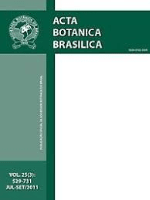
Acta Botanica Brasilica
Scope & Guideline
Empowering Botanists with Quality Research Insights
Introduction
Aims and Scopes
- Plant Conservation and Biodiversity:
The journal emphasizes research related to the conservation of plant species, particularly those that are endangered or endemic to Brazil, with studies that propose conservation strategies and assess biodiversity. - Ecological Interactions and Plant Physiology:
Research on plant-environment interactions, including physiological responses to abiotic factors like salinity and climate change, is a core focus, providing insights into plant adaptability and resilience. - Taxonomy and Systematics:
Acta Botanica Brasilica publishes taxonomic revisions and phylogenetic studies that enhance the understanding of plant classification and nomenclature, contributing to the scientific foundation for biodiversity studies. - Floristic Studies and Ecology:
The journal covers floristic inventories and ecological assessments of various biomes in Brazil, contributing to the understanding of species distribution and ecological dynamics. - Mycorrhizal and Fungal Interactions:
Research on the role of fungi, particularly arbuscular mycorrhizal fungi, in plant ecology and their influence on biodiversity and ecosystem functioning is a recurring theme.
Trending and Emerging
- Climate Change and Its Impact on Flora:
Recent publications increasingly address the effects of climate change on plant species, highlighting adaptive mechanisms and potential shifts in distribution patterns as critical areas of focus. - Molecular and Genomic Studies:
There is a growing trend towards molecular research, including genomic studies that investigate genetic diversity and evolutionary relationships among plant species, enhancing our understanding of plant biology. - Plant-Pollinator Interactions:
Research on the dynamics of plant-pollinator interactions is gaining traction, emphasizing the importance of these relationships for plant reproductive success and ecosystem health. - Sustainable Management and Restoration:
Emerging themes include studies on sustainable management practices and ecological restoration techniques aimed at rehabilitating degraded areas and enhancing biodiversity. - Microbial Interactions and Plant Health:
The role of endophytic and mycorrhizal fungi in promoting plant health and resilience is increasingly recognized, leading to a rise in research exploring these relationships.
Declining or Waning
- Invasive Species Research:
Although still relevant, the frequency of studies specifically focused on invasive plant species and their impacts has decreased, possibly due to a broader focus on conservation and native species restoration. - Traditional Uses of Plants:
Research highlighting traditional uses of plants, particularly in ethnobotany, has seen a decline, likely overshadowed by more pressing conservation and ecological studies. - Aquatic Plant Studies:
The number of publications focusing on aquatic plants and their ecological roles appears to be waning, with fewer studies addressing these ecosystems as compared to terrestrial environments.
Similar Journals
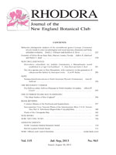
RHODORA
Nurturing Insights in Botanical StudiesRHODORA, published by the New England Botanical Club Inc, is a prominent journal dedicated to the field of botany, specifically focusing on Horticulture and Plant Science. With a rich history dating back to its founding years and ongoing publication from 1995 to 2024, this journal serves as a vital platform for disseminating research, reviews, and advancements in botanical studies. Though classified in the Q4 quartile for both horticulture and plant science in 2023, RHODORA remains an essential resource for researchers and practitioners, providing insights into plant ecology, conservation, and cultivation practices. While it does not offer Open Access options, the journal's commitment to quality research in a highly specialized field makes it a significant contributor to the botanical sciences, fostering collaboration and innovation among scholars and professionals in the United States and beyond.

PLANT SYSTEMATICS AND EVOLUTION
Cultivating Insights into Plant BiodiversityPlant Systematics and Evolution is a prestigious journal published by Springer Wien, dedicated to advancing research within the fields of plant taxonomy, evolution, and ecology. With its ISSN 0378-2697 and E-ISSN 1615-6110, this journal has been pivotal in shaping the scientific landscape since its inception in 1974. Based in Austria, it occupies a significant position in the academic community, being ranked in the Q2 quartile in both Ecology, Evolution, Behavior and Systematics and Plant Science as of 2023. This high-impact journal is recognized for its rigorous peer-review process and is indexed among the top publications in its category, holding a Scopus rank of #176 out of 516 in Plant Science and #252 out of 721 in Ecology, highlighting its relevance and quality in the research community. Although it does not currently offer open access, the journal is committed to making significant contributions to the understanding of plant biodiversity and evolutionary processes. This makes it an essential resource for researchers, professionals, and students aiming to know the latest developments in the study of plant systematics and evolution.

Willdenowia
Exploring the depths of plant sciences and ecology.Willdenowia is a prestigious scientific journal published by the Botanischer Garten & Botanische Museum Berlin-Dahlem, dedicated to advancing the field of botany and plant sciences. With an ISSN of 0511-9618, this journal has established itself as a crucial platform for researchers, practitioners, and students interested in ecology, evolution, behavior, systematics, and plant science. The journal boasts an impactful reputation, evidenced by its impressive Q1 and Q2 quartile rankings in Plant Science and Ecology, Evolution, Behavior and Systematics respectively, as well as notable Scopus rankings, placing it within the top quartiles of its categories. Although access is not open, articles published in Willdenowia contribute significantly to the global body of botanical research, making it an essential resource for anyone looking to deepen their understanding of plant biology and related ecological disciplines. The journal has continuously evolved since its inception and aims to facilitate interdisciplinary collaboration and knowledge dissemination in the life sciences.
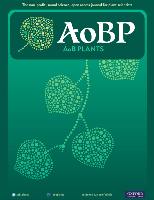
AoB Plants
Leading the way in plant science advancements.AoB Plants is a distinguished open-access journal published by Oxford University Press, dedicated to advancing the field of plant science. Since its inception in 2009, this journal has played a pivotal role in disseminating high-quality research that encompasses a wide range of topics including plant biology, ecology, and biotechnology. With an impressive impact factor and a ranking in the Q1 quartile for Plant Science, AoB Plants is recognized for its innovative contributions and scholarly rigor, ranking #129 out of 516 in the Scopus Agricultural and Biological Sciences category, placing it in the 75th percentile among its peers. By promoting open-access availability of research findings, the journal empowers researchers and practitioners alike, facilitating greater collaboration and knowledge sharing in the global scientific community. Situated in the heart of the United Kingdom, AoB Plants continues its commitment to providing a platform for pioneering research and developments in plant science, thus fostering a deeper understanding of the crucial roles that plants play in our ecosystems and economies.
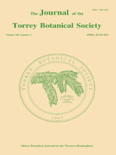
JOURNAL OF THE TORREY BOTANICAL SOCIETY
Advancing botanical knowledge, one discovery at a time.JOURNAL OF THE TORREY BOTANICAL SOCIETY is a prominent academic journal dedicated to advancing the fields of botany and ecology, published by the esteemed TORREY BOTANICAL SOCIETY. With an ISSN of 1095-5674 and an E-ISSN of 1940-0616, this journal serves as a critical platform for researchers, professionals, and students to share their findings and insights. Despite its status in the Q4 category for the 2023 rankings across Ecology, Plant Science, and Ecology, Evolution, Behavior and Systematics, the journal continues to foster significant discourse and collaboration in the botanical sciences, aiming to elevate the understanding of plant biology and ecosystems. Its open access options enhance accessibility, ensuring that groundbreaking research reaches a wider audience. Published in the United States, the journal features work from both established scientists and emerging scholars, making it a vital resource for anyone involved in the study of plants and their environmental interactions. Explore the JOURNAL OF THE TORREY BOTANICAL SOCIETY to engage with cutting-edge research and contribute to the ongoing dialogue in the botanical sciences.
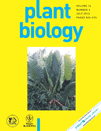
PLANT BIOLOGY
Nurturing Insights into Ecological SignificancePLANT BIOLOGY is a prestigious academic journal published by Wiley, dedicated to advancing knowledge in the fields of plant science, ecology, and evolutionary biology. With an impressive impact factor and ranking in the Q1 category for Ecology, Evolution, Behavior and Systematics, and Plant Science as of 2023, it stands at the forefront of research dissemination. The journal encompasses a broad scope of plant biology topics, providing a critical platform for researchers to share innovative findings and foster interdisciplinary collaboration. Available in both print (ISSN: 1435-8603) and online formats (E-ISSN: 1438-8677), it ensures accessibility through open access options. As a crucial resource for professionals, researchers, and students alike, PLANT BIOLOGY cultivates a deeper understanding of plant systems and their ecological significance, making it an essential addition to the library of anyone dedicated to the study of biology and the environment.

TELOPEA
Elevating Knowledge in Ecology and Plant SciencesTELOPEA is a distinguished scholarly journal published by the Natl Herbarium New South Wales, focusing on the rich fields of Ecology, Evolution, Behavior, and Systematics, as well as Plant Science. With an ISSN of 0312-9764 and an E-ISSN of 2200-4025, the journal has been a significant contributor to the understanding of plant biodiversity and ecosystem dynamics since its inception in 1984, with regular publication resuming in 2006 through to 2024. Residing in the beautiful Australian Botanic Garden at Mount Annan, NSW, TELOPEA operates under a Q3 ranking for both Ecology and Plant Science as of 2023, reflecting its relevance and contribution to these critical scientific disciplines. Though it does not offer open access, the journal remains an essential resource for researchers and professionals seeking to contribute to and stay abreast of the latest developments in plant sciences and ecological research. With a commitment to rigorous peer review and the dissemination of high-quality research, TELOPEA stands as a vital platform for advancing knowledge in the realm of plant ecology and systematics.

MYCORRHIZA
Connecting Ecology and Molecular BiologyMYCORRHIZA is a prestigious journal dedicated to the exploration of mycorrhizal symbiosis and its implications across various biological disciplines. Published by SPRINGER, this journal serves as a crucial platform for researchers and professionals in the fields of ecology, plant science, and molecular biology. With an impressive impact factor reflected in its 2023 quartile rankings—ranking Q1 in both Ecology, Evolution, Behavior and Systematics and Plant Science, as well as Q2 in Genetics and Molecular Biology—MYCORRHIZA plays a significant role in disseminating groundbreaking findings that advance our understanding of plant interactions and ecosystem dynamics. The journal has been active since 1991 and continues to publish cutting-edge research through 2024, ensuring that its audience remains at the forefront of scientific innovation. For additional information about publication protocols and submission guidelines, please refer to the journal's website.

PLANT BIOSYSTEMS
Advancing Research in Plant Systems and Their EnvironmentsPLANT BIOSYSTEMS, published by TAYLOR & FRANCIS LTD, is a leading academic journal dedicated to advancing the understanding of plant systems and their ecological interactions. With an ISSN of 1126-3504 and an E-ISSN of 1724-5575, this journal holds a significant place in the fields of Ecology and Plant Science, earning a Q2 rank in both categories as of 2023. Established in 1993 and continuing robustly through to 2024, it aims to provide a platform for pioneering research that encompasses a wide array of topics, from evolutionary biology to plant-environment interactions. Although not an open-access journal, it maintains a strong reputation, backed by its impressive Scopus rankings—positioned at #179 in Ecology, Evolution, Behavior and Systematics and #138 in Plant Science, placing it within the top percentiles. PLANT BIOSYSTEMS is a vital resource for researchers, professionals, and students who are keen to contribute to and learn from cutting-edge findings in the ever-evolving domain of plant sciences.
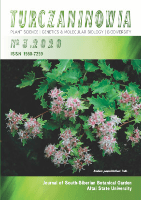
Turczaninowia
Empowering Discoveries in Organic Chemistry and EcologyTurczaninowia is a distinguished open access academic journal published by Altai State University, located in Barnaul, Russia. With an ISSN of 1560-7259 and an E-ISSN of 1560-7267, this journal has been committed to disseminating high-quality research since it adopted an open access model in 2013. Spanning diverse fields including Biomaterials, Ecology, Organic Chemistry, and Plant Science, Turczaninowia has established itself in the Q3 category of academic journals, reflecting its consistent contribution to environmental sciences and biological research. The journal holds a respectable ranking in Scopus, including a position of #360/461 in Environmental Science and #599/721 in Ecology, Evolution, Behavior and Systematics, highlighting its relevance in the scientific community. With a publication convergence period from 2016 to 2024, Turczaninowia aims to provide a comprehensive platform for researchers, professionals, and students to explore innovative findings and share insights, fostering an environment of collaborative learning and advancement in their respective fields.